Hi my name is Florian Kohler also known as Venom. Joining me is Jamillette. In the last few months we've covered all the basics of pool. So today we're going to go over some advanced billiard shots because sometimes to win a game of pool, we need to know more than just the basics. So today, we're going to learn some more advanced shots. I'm going to start with what we call the massé shot.
How to Curve the Cue Ball with a Massé Shot
A massé shot is when you curve the ball, so that means instead of the ball going in a straight line, it's going to curve. It's probably one of the harder shots in pool, it's really not easy to explain, but I'm going to try to go over it. Again, you're going to use the spins, you know, left and right, and you're going to combine all that. So the only difference between the massé and a normal spin shot, is with a normal shot you're basically flat with the cue parallel to the table, as much as possible. For a massé you're going to raise your cue over 45 degrees usually. So this is a very typical situation for example.
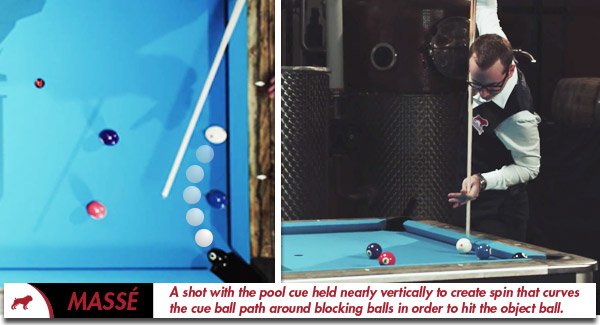
If the cue ball is here, and you have to make the eight ball because I played bad position or my opponent played a safety. I can't kick it here. I can't really go three rails, I mean it's pretty difficult. So the easiest way would be to massé it. I'm just going to try and hit the white ball around the two and make the eight ball. Just like that. And that's how you get away of a very difficult situation and still win the game.
Now to explain the massé. It's, like I said, one of the most complex shots in pool. It's not very easy, but there's some basic rules.
We're going to take the cue ball, and think of it as a clock, but instead of hitting it from the side. We're going to hit it from up top. Raise your cue like this. You can raise it from 45 to 90 degrees depending on how far you want to go and how much curve you want to get.
How to Massé Left, Right and Straight Back
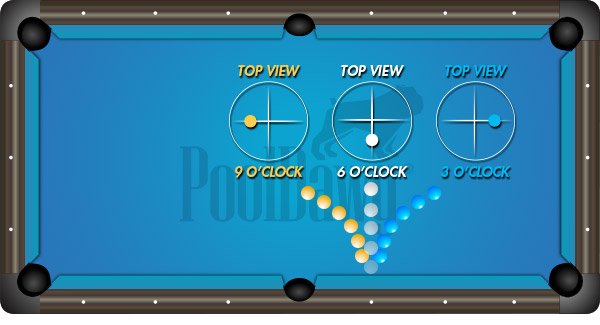
So first we’re going to hit 6 o’clock. I'll show you what it does. It's basically going to go straight back to me. I'm going to do the same thing, and I'm going to go for 9 o’clock for example. So, right here I'm going to hit 9 o’clock, and you see the ball goes totally on the left side. Now let’s do the exact same thing, but with 3 o'clock, which will go to the right side. And now you can combine all that.
Let’s say you want to hit 7 o’clock, so we're going to hit it here to the left side.
Using a Combination of Spins for Massé Shots
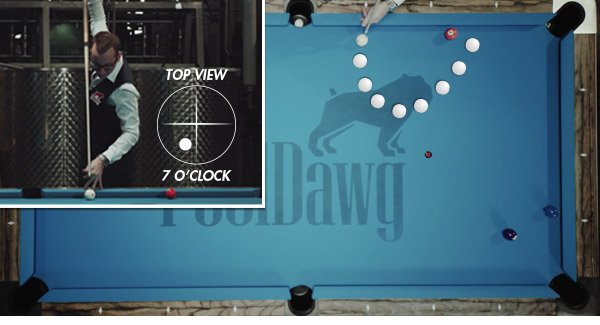
And the ball goes back to you, with a little bit of left.
So of course it looks easy like that, but it's very hard to judge a massé, because it's going to depend on the table. How much it slides, and if the balls are clean or dirty it's going to be harder. But it really can save you in some desperate situations.
Not all massé shots are so vertical. A lot of time, you have to do what I call a "semi-massé.”
Let's say I'm here and I want to make the eight ball, which is in the corner out there. And I have this ball blocking it. I can try to kick it, but maybe some object balls are going to block me. Even so, it's still a pretty hard shot, but you can do what I call a semi-masse.
Semi-Massé Shots
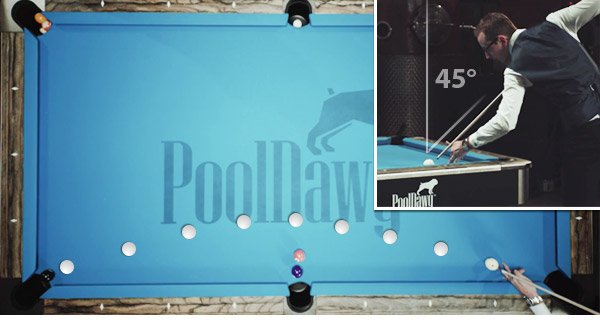
So raise your cue about 45 degrees and hit the cue ball with a lot of left spin. And again, this can save you from a desperate situation.
Take some practice shots, but I can't really advise you to do in your local pool hall. If you do, please try to protect the table. Practicing these shots can leave pretty bad marks, especially if you aim at a steep angle and you follow through into the felt, which is going to cut the felt. You really don't want to do that in any pool hall, so if you practice these shots, try to protect the table.
 Frank Says: "If you’re practicing massé or jump shots, the best way to protect your cloth from burn marks and tears is with Stefano Pelinga’s Cloth Shields. Try one!"
Frank Says: "If you’re practicing massé or jump shots, the best way to protect your cloth from burn marks and tears is with Stefano Pelinga’s Cloth Shields. Try one!"
What I need to insist about the massé shot is that people always think you just hit the ball and don't hit the felt, but you actually do hit the felt when you do a massé shot.
If you take a look at a close up, when you hit the ball it's going to leave a white mark on the table. This is a burn mark from the friction of the spinning ball. If you look, you’ll also see the mark from your tip. So you can see the white spot here, and then the mark from the chalk on your tip. If you do it at a good angle, you won't make a hole and it will just leave a burn mark. But if you do it at a bad angle, you might cut the felt which is which is very bad.
It takes some practice, and it's not advised if you're just a beginner. Once you get used to pool and you start getting serious, it's a very mandatory shot to learn.
How to Perform a Legal Jump Shot
Massé shots are very difficult, and sometimes it's easier to actually jump a ball. A popular belief in pool is that to jump a ball, you have to get your cue under the ball and kind of lift it up.
But that's actually a foul, so you can never do that. If you see somebody that does that, that is bad. Don't ever do that. First off you have to aim low, which might rip the felt or leave a bad mark. It's not good pool halls don't want to see that. And second of all it's a foul, literally. In pool, you cannot put your tip under the ball and lift it up.
Right Verses Wrong Way to Jump the Cue Ball
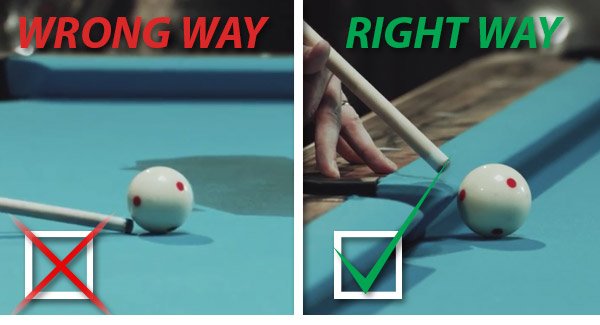
To execute a proper jump shot, you need what we call a jump cue. It's possible to do it with a normal cue, but it's a lot easier with this kind of cue. A jump cue is a shorter cue. It's a lot lighter, the wood is a little bit harder, and the tip is also very hard, usually what’s called a phenolic tip. It's a little bit different, it's not like a normal leather tip.
How Jump Cues Are Different From Standard Pool Cues
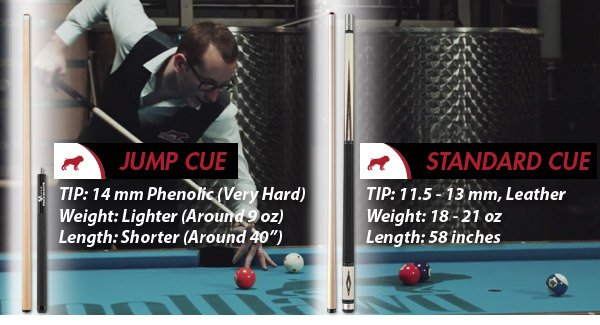
We're going to change cues, and I'm going to show you how to do a proper jump shot. The best way I can demonstrate it is to put the white ball here on the rail so that it’s frozen to the rail. Let's shoot at the three ball about a diamond away. Always chalk your cue as usual.
Like I said before, a jump shot is not under the pool ball. If the cue ball is on the rail, frozen, you cannot hit below the center of the ball. You're going to hit above the center of the cue ball at about a 45 degree angle.
In planning the shot, you can hit lower if you want to shoot further and you can hit higher if you need to jump from closer. A jump shot is it's a pretty easy shot, actually, but it's very different than a normal pool shot.
Gripping the Cue for Jump Shots
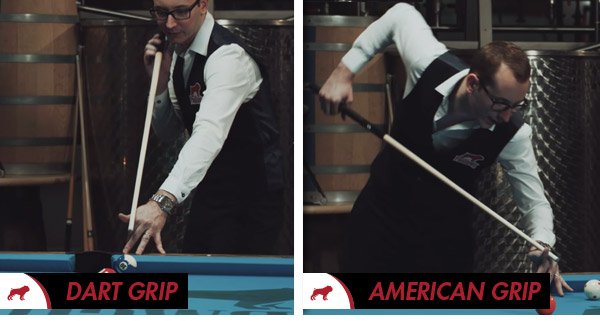
A normal pool shot has a long, steady follow through, and a jump shot to me is a short fast poke. I'll show you what it does. So again it's a short fast poke. There are several methods, but the one I use most often is called the "dart grip.” It’s kind of like you're throwing a dart. So you put two or three fingers here, and it's just a very quick release poke, a short fast poke. You never really follow through to the table.
But, there is another way, which is basically the normal way. It’s what I call the "American grip.” It's kind of like when you're holding your pool cue. You're going to hold it the same way, but you're going to grip a little tighter here. Same thing also 45 degrees, and that requires a little more follow through.
It depends on the person, some people like the dart grip and some people like the American grip. To me, the American grip is going to allow you to aim better. While the dart grip is going to allow you to jump easier.
I'm going to go ahead and set up a jump shot for you. If the balls are set up like this, I could massé the ball, you know, but in this case it's very difficult because the ball is very far from the pocket. A massé is a lot easier when the object ball is close to the pocket. In this case, it's clearly a jump shot. So I'm going to go ahead and line up my shot, try to aim for it. Just like that. And that's another lifesaving shot for when your opponent plays a safety or if you just played bad position.
Equipment
I showed you how to massé and how to jump. You can do a massé with a normal cue, and you can do a jump shot with a normal cue, but mainly a jump cue. If you really want to do an extreme massé, you need what is called a massé cue.
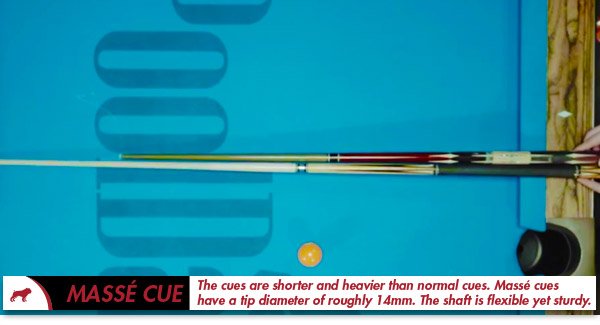
As you can see a massé cue is going to be a lot shorter. So you know you're going to cut that much off a normal cue. The tip is bigger, so it’s fourteen millimeters, and it's also usually softer. And the shafts are also thicker so more rigid. But the main thing is it's a heavier cue, which is going to allow you to hold it vertically, which is going to help you go further with the ball.
This is only a cue I would recommend if you're you know start to really push the game further and especially if you’re going to try to do a few trick shots.
Jump and Massé Drills to Hone In Your Skills
Ok, so the best way for me to teach you how to jump a ball is to practice this drill. I just put the 1, 2, and 3 balls frozen to the rail and frozen to each other, and then the 9, 10, and 11 about a diamond away. It's about as easy as it gets for distance. So again just grab your jump cue, raise it 45 degrees, and with a short fast poke we're going to try and make the 1, the 2, and the 3 without touching this line out here.
Jump Drill
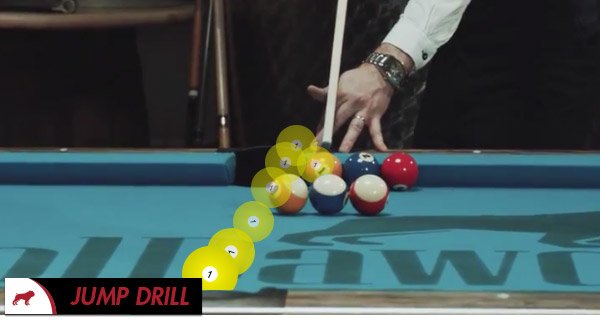
Now, I only set up three balls, but you could put a lot more balls on the table. The more you put on the table, the tougher the angle is going to be. But it's basically the best drill you can get. Again, if you do this in a pool hall, please put down a piece of felt or something to protect the table so you don’t leave burn marks.
On the massé shot, I don't have as many drills for you because you're going to have figure it out by yourself. But what you can do is you can just simply put the white ball here, the 9 ball there, and then put a ball at this distance and try to massé this ball into the 11, then move the 11 further towards the pocket.
Massé Drill
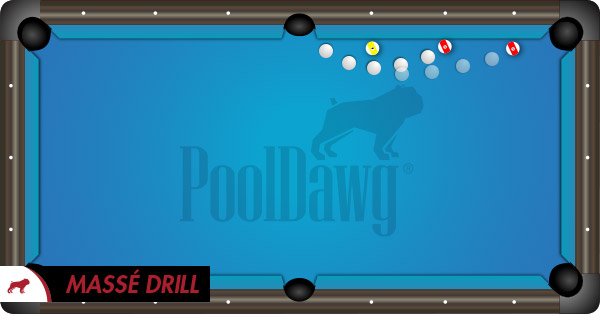
And what you're going to do is you're going to try to find your way, so you can identify how much spin and how much backspin you need to put on each ball. Practicing this is going to be really helpful for you to judge massé shots.
The massé is a very instinctive shot, so it's going to take some time. But it will be worth it at the end of the day.
OK. I know that seemed pretty difficult, right? But with this guy's help, I'm pretty sure you're gonna get it. And make sure to check out our next episode Rack and Break.
That's it! And if you want to see more, please subscribe to my channel and check out PoolDawg.com for all your pool and billiard supplies.
* Video transcript has been modified for the reader
- RELATED ARTICLES
- Failure To Launch - 6 Tips For Better Jump Shots – by Jennifer Barretta
- How To Control Jump Shots – by Tom Simpson
- Kick, Jump, Or Curve – by Mark Finkelstein